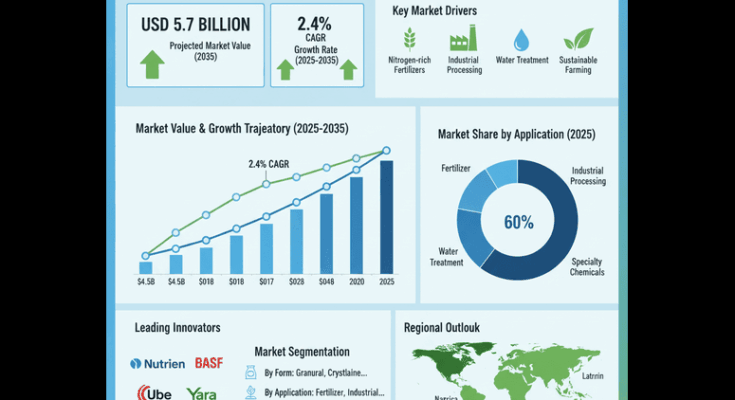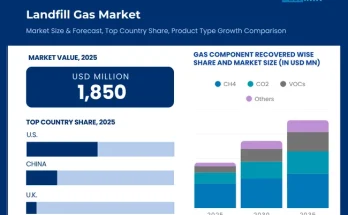The global ammonium sulfate market is poised for steady expansion, with an estimated value of USD 4.5 billion in 2025, projected to reach USD 5.7 billion by 2035, advancing at a CAGR of 2.4% during the forecast period. Rising demand for nitrogen-rich fertilizers, advancements in industrial processing, and increased use in water treatment and specialty chemical applications are among the key factors driving this growth.
Expanding Role of Ammonium Sulfate in Agriculture
Ammonium sulfate (NH₄)₂SO₄ has long been valued as a reliable nitrogen fertilizer, especially in regions with sulfur-deficient soils. It provides essential nutrients for plant growth and improves soil fertility. The fertilizer segment continues to dominate the global market, driven by the growing need to enhance crop yields amid shrinking arable land and the pressures of feeding an expanding global population.
Farmers in Asia-Pacific and Latin America are increasingly turning to ammonium sulfate due to its high solubility and compatibility with other fertilizers. The compound’s ability to improve nitrogen uptake efficiency makes it an important component in precision agriculture. Additionally, growing emphasis on sustainable farming practices has encouraged the use of ammonium sulfate as part of balanced nutrient management systems, aligning with global sustainability goals.
Rising Industrial and Chemical Applications
Beyond agriculture, ammonium sulfate serves as a versatile ingredient in industrial and chemical processing. It is used as a flocculating agent in water treatment, a precursor in specialty chemicals, and a stabilizer in food and pharmaceutical manufacturing. These applications are expanding steadily as industries seek cost-effective and eco-friendly raw materials.
In industrial settings, ammonium sulfate plays a critical role in protein purification and flame retardant production, as well as in textile and leather processing. The growing industrialization in emerging markets and the adoption of cleaner production technologies are further supporting demand across the chemical sector.
Market Segmentation Overview
By Form:
-
Granular: The most widely used form in agriculture, offering easy handling and uniform nutrient distribution.
-
Crystalline: Commonly utilized in industrial and laboratory applications.
-
Liquid: Gaining traction in water treatment and certain specialty chemical uses due to ease of integration in liquid systems.
By Application:
-
Fertilizer: Dominant segment, fueled by global agricultural expansion and rising demand for nitrogen-based fertilizers.
-
Industrial Processing: Increasingly applied in food additives, pharmaceuticals, and flame retardant production.
-
Water Treatment: Used for purification and removal of impurities in municipal and industrial water systems.
-
Specialty Chemicals: Supports niche applications in biotechnology and analytical chemistry.
By Region:
-
Asia Pacific: Leads global production and consumption, with China and India at the forefront due to robust fertilizer demand.
-
North America: Witnessing steady growth, supported by industrial applications and sustainable farming initiatives.
-
Europe: Focused on eco-friendly fertilizers and circular economy strategies to reduce nitrogen runoff.
-
Latin America & Middle East & Africa: Emerging markets benefiting from agricultural modernization and infrastructure growth.
Competitive Landscape: Key Players Driving Innovation
The ammonium sulfate market features a blend of global chemical giants and specialized producers. Nutrien, BASF, Ube, KuibyshevAzot, Evonik, and Yara are among the leading companies shaping the market landscape.
These players are focusing on strategic capacity expansions, mergers, and technological advancements to strengthen their global presence. For instance:
-
Nutrien continues to enhance its fertilizer production capabilities, emphasizing sustainable nutrient solutions.
-
BASF leverages integrated chemical production networks to optimize ammonium sulfate output.
-
Evonik and Yara are investing in advanced sulfur recovery systems to improve efficiency and reduce emissions.
Collectively, these initiatives are expected to foster supply stability, product quality improvements, and innovation in value-added formulations.
Sustainability and Future Outlook
Sustainability is becoming a defining trend in the ammonium sulfate market. With environmental concerns over nitrogen emissions and soil acidification, manufacturers are innovating to create low-impact production methods and blended fertilizers that optimize nutrient release.
In addition, the rising adoption of bio-based fertilizers and integrated nutrient management systems presents new opportunities for ammonium sulfate producers. Its dual nutrient composition (nitrogen and sulfur) makes it indispensable in addressing micronutrient deficiencies while supporting global sustainability initiatives.
Market Outlook through 2035
The decade ahead will witness growing demand across key industries:
-
Agriculture will continue to account for the lion’s share of consumption, supported by population growth and food security initiatives.
-
Industrial and specialty chemical sectors will expand due to innovations in manufacturing and material science.
-
Water treatment applications will increase as governments strengthen environmental regulations and promote wastewater recycling.
By 2035, the ammonium sulfate market is expected to be valued at USD 5.7 billion, signaling stable long-term growth. As producers emphasize eco-efficient processes and regional supply-chain integration, the industry is well-positioned to meet both agricultural and industrial needs sustainably.
Browse Full Report: https://www.factmr.com/report/4544/ammonium-sulfate-market



